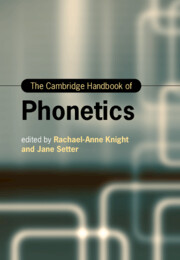Book contents
- The Cambridge Handbook of Phonetics
- Cambridge Handbooks in Language and Linguistics
- The Cambridge Handbook of Phonetics
- Copyright page
- Contents
- Figures
- Tables
- Contributors
- Introduction
- Section I Segmental Production
- Section II Prosodic Production
- Section III Measuring Speech
- Section IV Audition and Perception
- Section V Applications of Phonetics
- 20 Pedagogical Approaches
- 21 Pronunciation Teaching
- 22 Sociophonetics
- 23 Developmental Phonetics of Speech Production
- 24 Clinical Phonetics
- 25 Forensic Phonetics
- 26 The Phonetics of Talk in Interaction
- 27 The Phonetics/Phonology Interface
- Index
- References
27 - The Phonetics/Phonology Interface
from Section V - Applications of Phonetics
Published online by Cambridge University Press: 11 November 2021
- The Cambridge Handbook of Phonetics
- Cambridge Handbooks in Language and Linguistics
- The Cambridge Handbook of Phonetics
- Copyright page
- Contents
- Figures
- Tables
- Contributors
- Introduction
- Section I Segmental Production
- Section II Prosodic Production
- Section III Measuring Speech
- Section IV Audition and Perception
- Section V Applications of Phonetics
- 20 Pedagogical Approaches
- 21 Pronunciation Teaching
- 22 Sociophonetics
- 23 Developmental Phonetics of Speech Production
- 24 Clinical Phonetics
- 25 Forensic Phonetics
- 26 The Phonetics of Talk in Interaction
- 27 The Phonetics/Phonology Interface
- Index
- References
Summary
The phonetics/phonology interface refers to the relationship between the physical dimensions of phonetics and the abstract arrangement of phonemes and their manifestations within the phonological systems of languages. This chapter provides an overview of a range of approaches to the investigation of the phonetics/phonology interface, with particular attention to the relationships between phonetic factors such as positional prominence, acoustic salience and articulatory gestures, and phonological phenomena such as segment features and inventories, assimilation, and tone. I survey several clusters of theoretical orientation, each with distinct theoretical underpinnings and claims about the extent to which phonological concepts encode, reflect or direct phonetic details. I conclude with a discussion synthesising these seemingly disparate approaches, unifying them around a theme of linking the continuous physical dimensions of phonetic science with the abstract cognitive categories and rules of combination that typify phonological models. I discuss pedagogical implications and new directions in which facets of the interface can be explored.
Keywords
- Type
- Chapter
- Information
- The Cambridge Handbook of Phonetics , pp. 682 - 706Publisher: Cambridge University PressPrint publication year: 2021
References
27.7 References
- 1
- Cited by



